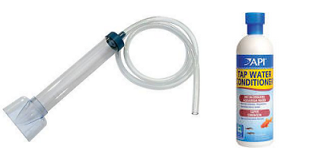Water Changes
 |
The Equipment
Doing water changes on your tank is very important if you want to keep your fish healthy and the smaller the tank the more often you need to do them. When I was running my 84" x 24" x 18" and other large fish Tanks I did the main water change every 4 weeks replacing around a quarter to a third of the water but in-between water changes I also replace a few gallons.
I always use an electronic PH Monitor so that I can keep an eye on the PH levels. Small tanks get a quarter to a third of the water changed weekly. All of my water changes are done using a gravel cleaner so that I can syphon up any debris and waste food from the substrate.
The water is always treated with T.A.P water conditioner which removes chlorine and detoxify heavy metals from the tap water. When you do a water change make sure that the bucket you use is only intended for that job and has not been used for anything else. Another handy tool to have if you use power-heads or internal filters is a toothbrush, they are excellent for cleaning out any debris that has got trapped and are very inexpensive but remember to use one that has not been used for anything else.
I currently use CaribSea Eco-Complete African Cichlid substrate to help buffer the water as commercial water treatments and buffers such as cichlid chemistry (not water conditioners) can work out to be quite expensive if you have a large tank. However there is a homemade remedy that works just as well. The following information is provided by M.C.H.
"Common bicarbonate of soda is effective at raising the PH, not to mention it is very inexpensive. Epsom salts (i.e magnesium sulfate) can be used to harden the water in lieu of calcium. Then you could also add aquarium salt (i.e non-iodized salt) to provide trace elements and potassium. For every 5 gallons of water add 1 tablespoon of Epsom salts, 1 teaspoon of baking powder soda and 1 teaspoon of aquarium salt".
Getting the Job Done
If you use fine sand as your substrate then the best way of cleaning this is with a hosepipe or the pipe from the gravel cleaner. Hover the end of the pipe about an inch above the surface of the sand and syphon up all the waste. Once a month take out all your decor and stir up all the sand before using your pipe as over time sand can develop gas pockets which are actually Hydrogen Sulfide also known as H²S which is toxic to both you and your fish in large amounts.
If you use regular gravel which is not really recommended for Malawi cichlids, then just use a gravel cleaner in the standard way, stirring up the gravel with the end of the uplift then syphon out the water and debris as you go. On large tanks I always use 2 external filters which are cleaned out about every 4 - 6 weeks alternately. Each filter contains course sponge, ceramic rings, filter wool and crushed cockle shell.
It is always best to clean any filter media in tank water to preserve the good bacteria however as I never clean my filters at the same time I just use tap water. If you use internal filters and or power-heads and you notice that they are not working as well as they did then this is probably because they need cleaning. Unplug them from the mains and then take them to the sink and use a toothbrush and clean tap water to clean out any blockages. After unplugging all the electrical equipment and removing the hood, I begin by removing all the rocks into buckets.
Once removed I use a piece of filter wool and clean all along the inside of the glass removing any algae from the front and sides, I do leave some on the back glass if i have any catfish. Next I stir up all the substrate either with my hand, a old wooden spoon or the end of the gravel cleaner. As I have sand I do not use under gravel filter plates but to be quite honest they are out dated and not used much now. After stirring up the sand, I then "Hover" the gravel cleaner about an inch over the sand and syphon up all the debris. I do this 3 or 4 times, stirring then syphoning, then if there is any last remaining debris floating around I catch this by dragging a fine net through the water.
While you are syphoning you can hold your thumb over the end of the pipe going into your bucket which keeps the force of the water flow going but stops the water being syphoned up thus making any sand fall back down the tube. You can do this as often as you like during a water change and it saves syphoning up your sand.
Now is the time that i clean any equipment such as external filters and do any minor jobs that may need doing. Next is the job I am never very good at, putting all the rocks back in the tank, making sure that there is plenty different sized caves. I always check to make sure that the rocks are stable when I have finished.
Now I fill the tank with clean water which has been treated as described above. Once the tank is full I turn everything electrical back on, check the temperature and make sure that both of the external filters are working correctly. The last job is to clean the condensation trays with warm tap water and filter wool before replacing them and the hood. The front of the tank will also get a clean with a warm soapy sponge.
Written content © www.malawicichlids.co.uk
Page last updated on

 Water Changes
Water Changes